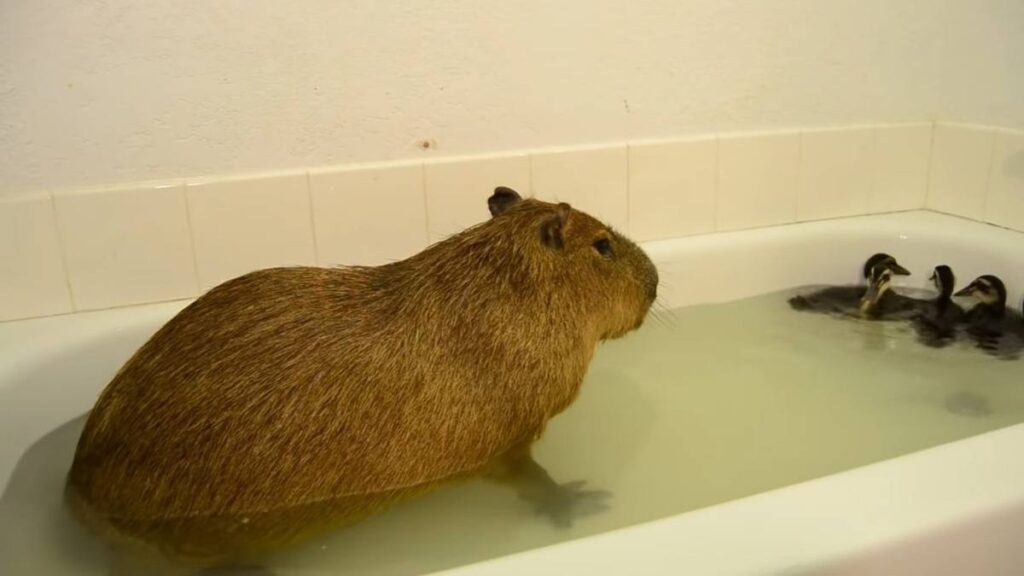Capybaras are fascinating creatures with unique characteristics. These semi-aquatic mammals are native to South America and capture animal enthusiasts’ curiosity and interest. They spend a lot of time in the water and have several remarkable features contributing to their adaptability to their natural habitat.
Despite their aquatic tendencies, capybaras require special hygiene attention to ensure their overall well-being. It is crucial for preventing dirt, parasites, and other contaminants from accumulating on their fur and skin. When it comes to capybaras’ hygiene, many people are lost on what to do or how to get about it.
You can bathe a capybara. However, you must note that capybaras are semi-aquatic animals who spend a lot of time in the water to regulate their body temperature and engage in various social and hygiene behaviors. Their dense, oily fur is a natural barrier against water and repels dirt and parasites.
While these rodents are generally self-sufficient in terms of cleaning themselves, there may be instances where bathing becomes necessary or beneficial. For example, if a capybara is exposed to a harmful substance or encounters a situation where its fur becomes excessively dirty, you should consider bathing them. This will remove contaminants and restore hygiene.
When it comes to bathing these social rodents, there are several common misconceptions you might have heard. Here are some misconceptions.
- Capybaras don’t need baths because they are already efficient at self-cleaning: While capybaras have natural adaptations to self-clean, there will be situations where bathing becomes necessary. Excessive dirt, exposure to harmful substances, or certain medical conditions require a gentle and controlled bathing process.
- Bathing capybaras is easy and similar to bathing a dog: Capybaras have specific needs and sensitivities. They are not fully aquatic creatures like fish or amphibians, so their bathing requirements differ. It is imperative to approach capybara bathing cautiously, using appropriate techniques and products.
- Capybaras enjoy bathing: While some capybaras may tolerate or enjoy bathing, they must recognize that each individual has their own preferences and comfort levels. Some capybaras may find bathing stressful, so it is crucial to approach it with sensitivity and respect for their well-being.
- Any soap or shampoo is suitable for bathing capybaras: Capybaras have sensitive skin, and using harsh or unsuitable products can cause skin irritation or other adverse reactions. It is imperative to choose mild, non-toxic shampoos specifically formulated for sensitive animals or seek guidance from a veterinarian experienced with capybaras.
- Bathing capybaras regularly is necessary for their hygiene: Capybaras have natural oils in their fur that repel dirt and maintain cleanliness. Frequent bathing can eliminate these oils and disrupt their natural balance, potentially leading to skin problems. Regular access to clean water bodies and appropriate environmental conditions usually maintain capybara hygiene.
Step-by-Step Guide on How to Bathe a Capybara
Although bathing a capybara is relatively easy, you must be cautious to prevent aggression or violence. Here is a step-by-step guide to bathing the below.
1. Gather the necessary supplies
Prepare a shallow container or tub large enough for the capybara to sit comfortably or stand in. Ensure it is sturdy and secure to prevent tipping. Fill the container with lukewarm water a few inches deep. Next, choose a gentle, non-toxic shampoo suitable for sensitive animals. You should consult with a veterinarian experienced with capybaras for product recommendations.
Once you have done these, place towels or soft blankets nearby for drying the capybara after the bath.
2. Introduce the Capybara to the Bathing Area
Approaching the capybara calmly and gently is the next thing to do to bathe these rodents. Use positive reinforcement and treats to make the capybara comfortable. Once they are comfortable, lead or guide the capybara toward the bathing area. Allow it to explore and familiarize itself with the space before starting the bath.
3. Bathe the capybara
Lower the capybara into the water slowly and gently, supporting its body to ensure it feels secure and safe. Then, wet the capybara’s body using a cup or your hand to pour water over it. You must avoid getting water in your ears or eyes. The rodent’s body should be wet before applying a small amount of gentle shampoo. Gently massage the capybara’s fur and pay special attention to dirty areas.
Ensure you do not rub too vigorously or discomfort the capybara. Then, rinse the capybara’s fur thoroughly with lukewarm water, ensuring all the shampoo is washed away. Use your hand or a cup to pour water gently over its body. You must avoid getting water in the capybara’s ears, which can lead to ear infections.
4. Dry the capybara
Once you have bathed the rodent, lift it out of the water and place it on towels or soft blankets. Gently pat and press the towels against their fur to absorb excess water. If the capybara tolerates it, use a hairdryer set on the lowest heat and speed setting to dry its fur further. Ensure the dryer is kept safe to avoid discomfort or overheating.
Alternatively, allow the capybara to air dry in a warm, draft-free area to prevent chilling. You must monitor the capybara closely during drying.
Are There Any Precautions or Safety Measures When Bathing Capybaras?
Yes. There are several safety measures to observe when bathing capybaras. Here are some of the measures below.
- Maintain a Calm and Quiet Environment: Capybaras are sensitive animals, and a calm and quiet atmosphere is crucial during bathing. Avoid loud noises, sudden movements, or stimuli that may startle or stress the capybara.
- Use the Appropriate Water Temperature: Ensure the water temperature is lukewarm, neither too hot nor too cold. Test the water with your hand or a thermometer to ensure it is comfortable for the capybara. Extreme temperatures can cause distress or discomfort.
- Avoid Submerging the Head: Capybaras are not natural swimmers and may feel uneasy or panicked if their head is submerged. Avoid getting water in their ears, eyes, or nose. Use a cup or your hand to pour water over their body gently.
- Handle gently and Massage: Handle the capybara carefully and gently during bathing. Avoid rough or forceful actions that may cause stress or discomfort. Use gentle motions while massaging or washing their fur to ensure a positive experience.
Can Capybaras Bathe in a Bathtub or a Pool?
Capybaras can bathe in a bathtub or pool. There are also other environments where capybaras can bathe. However, suitability depends on many factors, such as cleanliness and more.
Here are some bathing environments you can choose from.
1. Natural Water Bodies
Capybaras thrive in their natural habitats, including rivers, lakes, ponds, and marshes. These natural water bodies provide ample space for capybaras to bathe, swim, and socialize. They are typically the ideal and preferred bathing environments for capybaras.
2. Artificial Ponds or Enclosures
In captive settings or zoos, you can provide them with artificial ponds or enclosed water areas that mimic their natural habitats. These man-made ponds can be designed to provide capybaras with ample space to swim and engage in natural behaviors.
3. Kiddie Pools
Kiddie pools are suitable for capybaras, especially in residential or small settings. These shallow pools offer capybaras a chance to cool off and partially submerge themselves. Ensure the pool is large enough for the capybara to move around comfortably.
4. Large Outdoor Tubs or Water Troughs
Some Capybara caregivers provide large outdoor tubs or water troughs for bathing. These containers can be filled with clean water and provide capybaras with a designated area for bathing and relaxation.
Can You Use Regular Shampoo on Capybaras?
No. You cannot use regular shampoo on capybaras. Using regular shampoo intended for humans on capybaras is generally not recommended. Capybaras have unique skin and fur characteristics that differ from humans, and their bathing needs differ.
It is advisable to use shampoo or products specifically meant for these rodents. You can get a recommendation for these products from your vet doctor.
Conclusion
Capybaras are social rodents with remarkable features. These animals spend a lot of time in the water, allowing them to bathe. However, they might sometimes need to bathe when exposed to certain substances. This article discusses the steps and safety measures to bathe a capybara.
Do not forget to use products specifically recommended for these rodents when bathing them. Using other products might do more harm than good. As a final note, always provide them with treats while bathing, as this trick has always worked for me when bathing my capybaras.


![Why Do Capybaras Not Have Tails? - [Answered] Why Do Capybaras Not Have Tails](https://capybaratips.com/wp-content/uploads/2023/03/Capy-Tail-250x200.webp)

![Capybara Meat And Its Culinary Uses - [Every You Should Know] Capybara Meat & Culinary Uses](https://capybaratips.com/wp-content/uploads/2023/03/Capybara-meat-250x200.webp)

![How Long Do Capybaras Live? - [Answered] How Long Do Capybaras Live](https://capybaratips.com/wp-content/uploads/2023/03/Capybara-Pix-250x200.webp)
![How To Find A Lost Capybara - [Easy Tips] How To Find A Lost Capybara](https://capybaratips.com/wp-content/uploads/2022/05/Lost-Capybara.jpg)

